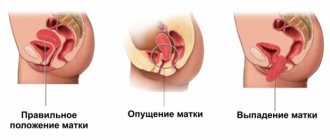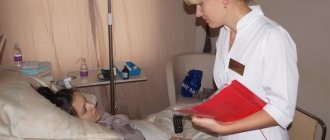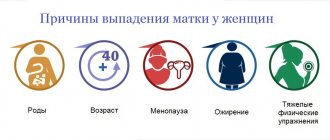Is a bandage needed after surgery?
The postoperative effect of the bandage lies in the external pressure that the Intex elastic belt exerts on the abdominal area after surgery and childbirth. Wearing a bandage after surgery : - Reduces the load on the postoperative wound, preventing the sutures from coming apart. — Improves blood circulation in the area of the postoperative wound, accelerating the formation of fibrin fibers. A durable scar is formed, eliminating the formation of a hernia - protrusion of internal organs through the scar area. — Provides external pressure on the postoperative suture, orienting fibrin fibers in the correct direction. This prevents the appearance of overgrown keloid scars. – Supports abdominal muscles weakened after surgery, helping the patient maintain a slim figure. — Fix internal organs in the correct position. This reduces the risk of the kidneys descending into the pelvic area.
How to wear a maternity bandage: 8 important points
A bandage is a special device made of dense elastic fabric that supports the expectant mother’s abdomen, reducing the load on the back and abdominal muscles.
There are prenatal and postnatal bandages. There are also universal models that can be worn not only during pregnancy, but also after childbirth, in order to support and quickly restore stretched abdominal muscles.
Additionally, support bands come in different shapes.
- Belt. It is an elastic band with special fasteners on the sides so that the height and tightness of the fit can be adjusted depending on the size of the abdomen. This bandage is worn over underwear, so it can be noticeable under clothing. But the belt also has its drawbacks. When wearing such a bandage for a long time, the abdominal muscles weaken (therefore, periodically you need to do massage and exercises). During wear, the belt can twist, slip, or, conversely, rise, and with slightly more intense physical activity, it can become twisted. Therefore, a bandage belt is not at all suitable for future mothers who are athletes;
- Panties. Essentially, this is underwear with a high waistline, into which a special elastic insert is sewn to support the pregnant belly. This is one of the most comfortable types of bandages to wear. In addition, it is not visible at all under clothes. But such a bandage requires daily washing (like any other underwear), and this is not always convenient. In addition, it is not suitable for women who are prone to significant weight gain during pregnancy. Bandage panties are not designed for strong stretching, so after a short period of time they will rub the skin and squeeze the stomach. The only way out in this situation is to buy several models “for growth.” Finally, in the summer it can be too hot in a panty bandage, which can lead to skin irritation;
- Universal bandage. It is very similar to a bandage belt with the only difference being that the universal model has a more comfortable design - it has wide and narrow sides. Before childbirth, the narrow part is used to support the abdomen, and the wide part is used to relieve stress from the back. After childbirth, the opposite is true. The wide part of the bandage helps to tighten the stomach after childbirth. The universal model has contraindications. It cannot be worn if the baby is in a breech or transverse presentation.
Why should pregnant women wear a bandage?
Experts are debating whether a bandage is actually needed or not and why. Some believe that the abdominal muscles of the average woman are quite capable of supporting the weight of an enlarged uterus and a growing fetus.
Other doctors believe that for some health conditions a bandage is simply necessary:
- spinal injuries in which serious stress on the back is prohibited;
- abdominal surgery in the abdominal cavity that took place less than one and a half years ago;
- scars on the uterus after cesarean section and other surgical procedures;
- large belly (multiple pregnancy, polyhydramnios, etc.);
- threat of miscarriage in the second and third trimester;
- low-lying placenta;
- weak pelvic floor and abdominal muscles due to previous pregnancies and childbirth;
- varicose veins and tendency to thrombosis;
- if a woman continues to engage in sports and other similar activities during pregnancy;
- pathologies of the uterus (for example, underdevelopment of the cervix);
- diseases of the spine (scoliosis, osteochondrosis).
It is worth noting that some pregnant women feel more comfortable in a bandage. Therefore, in addition to direct prescriptions, it is worth taking into account your own condition (of course, after consulting with your doctor).
The only case when a doctor may not recommend wearing a bandage is when the baby in the stomach at about 30 weeks has not yet taken the correct position (head down). Fixation with a bandage can keep the baby in the wrong position in the abdomen: this will lead to the appointment of a planned caesarean section.
How to choose a bandage and its size
The bandage should be as comfortable as possible to wear and not squeeze the stomach, which means it should fit perfectly.
How to determine size? It all depends on the type of bandage. The size of the belt and universal model corresponds to the one you wore before pregnancy (we are talking about clothes).
It is better to choose a panty size larger than the underwear you usually wear (for convenience, before purchasing, measure your hip circumference and compare it with the size chart).
Pay attention to the material from which the bandage is made. It should be stretchy to hold its shape and support your belly, but with added natural fibers to make it comfortable to wear.
Examine the fasteners and Velcro. They must be securely sewn to the base and be soft so that they do not rub the skin when worn.
Buy a bandage only in specialized stores, where you can try it on and see if it is comfortable. Refrain from buying a brace secondhand and do not take an inherited model. They are completely useless. Elastic fabric stretches during wear, which means a used bandage will not support the stomach as needed.
Also, listen to your baby's sensations in your stomach. If, after you put on the bandage, he begins to actively push, it means that he is uncomfortable with such support, and it is better to remove the bandage.
From which week should you wear a maternity bandage?
The doctor decides how long to wear a brace for pregnant women. There is no need for support in the first trimester: the belly is still too small and not burdensome.
Usually, the bandage begins to be worn from the 25th week of pregnancy (that is, from the fifth month), and if a woman is expecting twins or triplets, she has polyhydramnios or just a large belly, and even earlier. You can wear it until the 30th week of pregnancy, and then remove it so that the baby can turn head down before birth.
How long can you wear a maternity bandage?
If you have chosen the most comfortable bandage for yourself, you will not want to take it off at all. But you can’t do that! Constantly wearing a bandage can interfere with blood circulation in the pelvic organs.
The doctor will decide how long to wear the “support”. But the general recommendations are as follows: you can wear it every day, but no longer than three to four hours in a row (in total, the bandage can be worn for no more than 10 hours a day).
After this time, you must remove the bandage and “rest” for about half an hour. In addition, if you feel tightness or the baby begins to worry in the stomach, this is also a reason to immediately remove the “support”.
How to put on and take off a bandage
Regardless of the type of bandage, it is better to put it on while lying down. Firstly, it’s more convenient. Secondly, in a horizontal position, the area under the abdomen, in which the bandage is fixed, is open. The exception is the universal bandage: it is worn while standing.
The step-by-step sequence is as follows:
- lie on your back with a pillow under your buttocks;
- lie down for a while, allowing the baby to move upward to relax the abdominal muscles and relieve pressure on the bladder;
- carefully put on the bandage and fasten it (do not overtighten, but do not fix it too loosely: the bandage should fit tightly to the body, but not put pressure on it; it should be fastened just above the pubic bone);
- turn on your side, lie down for a while so that the baby in your stomach takes a comfortable position in the space limited by the bandage, and only then carefully get up.
The bandage should also be removed while lying down to prevent a sudden drooping of the abdomen.
- First, lie down for a while so that the baby moves up again.
- Remove the bandage and rest lying on your side for about 20 minutes.
How to wear a maternity bandage correctly
It all depends on the chosen bandage model.
The belt is worn strictly under the stomach. Do not tighten it too tightly or fix it too high - this will cause discomfort and stiffness when wearing.
The size-matched panty bandage will fit your figure exactly as needed. The only thing that matters here is your feelings: comfortable or not.
As for the universal bandage, during pregnancy it is worn with the wide side backward (to support the back), and after childbirth - forward (to tighten the abdomen).
Is it possible to sleep and sit in a bandage?
The bandage is needed to relieve the load from the back when the body is in an upright position. Of course, you can sit in a brace (it is quite difficult for a pregnant woman to stand or walk for 3-4 hours straight), but make sure that your back is straight at all times.
But under no circumstances should you sleep in a bandage! It will put pressure on your stomach while you sleep.
Source: https://news.myseldon.com/ru/news/index/216479921
https://youtu.be/gsCmPZcFDUs
How to choose a postoperative abdominal bandage?
What postoperative bandages are considered high quality? The postoperative bandage should fully relieve the postoperative suture and support the abdominal muscles, be comfortable to wear and not cause allergies. The postoperative Russian Intex bandage fits tightly to the abdomen, easing the load on the scar and abdominal muscles. The belt is made of durable, non-allergenic materials (latex, polyester, polypropylene - can cause allergic reactions of an individual nature), therefore it has a fine texture that allows you to wear the belt discreetly under clothing.
How long to wear a postpartum bandage?
The postpartum belt helps to restore your figure faster. It supports the muscles of the uterus and abdomen, increases muscle tone, and also reduces pressure on the spine. As a result of wearing such a product, back pain is significantly reduced, and leg fatigue also disappears.
There is no definitive advice on how long to wear a postpartum bandage. Specific recommendations should be given by the doctor under whose supervision the mother is. The average period of use of such a product is from 3 weeks to six months. Moreover, some women can do without a support belt, but in general it will not be superfluous.
When should I start wearing it?
The time to start using the postpartum belt is set individually for each woman. Some mothers are advised to put on a support bandage within a few hours after the end of labor, others only after a week. Only a doctor can give accurate recommendations, based on your general well-being, physiological state and how the birth process went.
When wearing a bandage, it is extremely important to maintain natural blood circulation. Therefore, you should not wear such devices for more than 12 hours. And even during this time period, it is necessary to remove the belt every 3 hours for about 40 minutes. This general recommendation must be followed for all types of products.
Is it necessary after natural childbirth?
In many cases, bandages are recommended for women who have had a caesarean section. However, in all other situations there is no prohibition on wearing tight fitting items. On the contrary, it will be useful for accelerated restoration of the figure, as well as for unloading the spine.
Thus, natural childbirth is not an obstacle to wearing a bandage. The only contraindications to its use are the following situations:
- The presence of sutures in the perineal area - a tightening belt will impair blood circulation, which will prolong the healing time of the sutures.
- The appearance of edema - as a rule, appears with kidney diseases, and then the bandage, on the contrary, will begin to compress the edematous areas.
In any case, before using postpartum compression devices, you should consult your doctor.
After childbirth, many women use orthopedic products, which are designed to make the first weeks easier and then return to their previous shape. However, to achieve maximum effect, it is important to know how to select a postpartum bandage. You also need to know how to put on and wear this accessory correctly.
How to choose a postpartum bandage
After the birth of a baby, women, even in ideal physical shape, cannot protect themselves from the problem of a distended abdomen. Removing fat is not an easy task. A bandage after childbirth will help facilitate and speed up the process of restoring your figure to its previous proportions.
How to make the right choice of a postpartum belt?
An incorrectly selected bandage can cause a lot of trouble for a woman. Instead of performing its beneficial functions of improving muscle tone, an unsuitable corset can lead to overstrain of the pelvic bones and harm the organs located in the lower abdomen. To avoid such mistakes before purchasing, you need to pay attention to the following items:
- To select the correct orthopedic pad, it is important to first measure your waist and hips. Manufacturers usually provide a table with sizes where you can choose the right option.
- High-end waist trainers are made from elastic fabrics based on natural fibers (cotton, microfiber, elastane). Natural materials absorb water well and allow the skin to breathe. There will be nothing wrong if preference is given to synthetic fabrics. Belts made of such fibers also reliably fix the position of the abdomen and remove excess moisture.
- Before purchasing a postpartum product, you should pay attention to the type of fastening elements. Multi-level fasteners optimally adjust the width of the belt, based on changes in body volume. This allows the brace to better fit the lumbar region.
- Unless absolutely necessary, you do not need to take an orthopedic pad that has already been used by others. Even if these are very good friends, in whose cleanliness you can be sure. The fact is that over time, the beneficial properties of the device disappear - they lose elasticity and no longer bring the former effect.
Belt models
There are three main types of postpartum compression bandages:
1. Combined (universal) belt. Suitable both before and after the birth of a child. Is the most affordable option. After childbirth, this type of product is worn with the wide side towards the stomach, and the narrow side towards the back.
Advantages:
- saves money, well, you need to purchase two products at once;
- increased level of hygiene;
- effectively performs its functions: thanks to the high back, the stomach is tightened, and the low back supports the spine, there is no pressure on the lower back.
Flaws:
- there is a possibility that the belt may seem uncomfortable after childbirth, even if the product fit perfectly during pregnancy;
- with frequent use, the corset quickly wears out, some girls note that their belt “did not last” until childbirth;
- may become deformed;
- slips.
2. Corset panties. With the help of such a product, excess layers are removed from the body, and the appearance of dimples and tubercles on the hips.
Advantages:
- perfectly corrects the parameters of the waist, hips, buttocks;
- you can choose models from a wide range of price segments - from budget options to premium class;
- large selection of products;
- does not roll down (if selected correctly);
- looks impressive under any clothes.
Flaws:
- difficult to tighten in the first days after pregnancy;
- the bandage is put on a naked body, which is unhygienic;
- it is inconvenient to visit the toilet and gynecological office (if special fastenings are not provided below);
- If the product is selected incorrectly, it will not be possible to adjust the model.
3. Bandage tape. This product, with the help of special Velcro, securely covers and tightens the stomach.
Advantages:
- serves as effective support for the spine;
- Easily adjusts to your figure using Velcro fasteners;
- does not cause difficulties when putting on, easy to remove;
- high hygiene;
- wide selection of models.
Flaws:
- elements of the belt are visible under tight-fitting clothing;
- when moving, it often rolls down onto the lower back;
- does not correct figure flaws.
Modern manufacturers of orthopedic products are improving the models of slimming corsets every year. A young mother, depending on her tastes, can easily buy a postpartum device that will fully correspond to her physiological characteristics.
How to put on a postpartum bandage correctly
It is important for any woman after childbirth to look beautiful and feel as comfortable as possible in her body. A special slimming corset can help with this, which within a few weeks of use will help restore your previous shape even after undergoing a major operation. How to wear a postpartum bandage? We will cover this issue further.
How to wear a bandage correctly after childbirth
To get the desired effect from using an orthopedic product, it is important to follow several rules. Following these instructions will affect the final result.
We list seven basic recommendations that every woman should know after giving birth.
- You should not put on a medical pad immediately after eating. You need to wait one to two hours for the food to digest. This measure can also prevent disruption of the stomach and intestines.
- Doctors do not advise eating while wearing a bandage. The tightening agent already compresses the abdominal cavity and pelvic bones, and during the meal this process can worsen and lead to mechanical overstrain of this area.
- Any version of the postpartum device should be tightened in a lying position, slightly raising the hips. Before this, it is important to bring all internal organs to their normal position.
- To prevent fainting, a young mother needs to get up without sudden movements.
- While still lying down, you need to check how naturally all the parts of the belt are secured. It is important that the postpartum tightening does not put pressure on the stomach and does not interfere with blood circulation.
- The bandage should be worn only after prior consultation with a gynecologist. Some women can use the belt immediately after giving birth, while others will have to wait a few more days.
- The wearing time of an orthopedic corset should not exceed a limit of 12 hours.
Period of use of the belt
The time for wearing a medical device is purely individual for each mother. This is due to the fact that each person has their own characteristics of muscle tissue development.
There are women for whom even a month of regular wearing of a bandage is enough to get rid of wrinkles at the waist and return the body to normal condition. Others, on the contrary, wear a postpartum corset for many months.
This is especially true for women in labor after artificial stimulation of labor or emergency caesarean section. They are recommended to wear the orthopedic pad for two to three months.
Source: https://kladzdor.ru/articles/beremennost-i-rody/kak-dolgo-nosit-poslerodovoy-bandazh/
How to choose a postoperative bandage?
In order to select an Intex bandage, you need to take two measurements (in cm): waist circumference and hip circumference. Then you need to compare the measurements with the tabulated intervals. Let's assume that your waist is 76 cm and your hips are 105 cm. These measurements fit into the intervals corresponding to size 3 (M).
The width of the postoperative bandage depends on the location of the scar. A belt with a width of 22 cm is suitable for people below average height, 30 cm - for people above average height. By average we mean a height of 175 cm for a man, 165 cm for a woman.
Chest bandages (thoracic)
They are prescribed in the following situations:
- Condition after surgery on the chest organs.
- Intercostal neuralgia,
- Chest contusion
- Fracture of 1-2 ribs
Let's look at it in more detail.
Condition after surgery on the chest organs.
Here we are talking, first of all, about heart surgery.
Why do you need a bandage in this case? After all, there are no intestinal loops in the chest, and a postoperative hernia is unlikely to occur.
The fact is that to access the heart during the operation, the sternum and sometimes the ribs are cut.
After surgery, the halves of the sternum are most often connected with a special wire. Less often - metal structures. They remain in the person's body for the rest of their life
In this case, a chest bandage is needed to provide rest to the sternum, ribs and the postoperative suture itself, so that bone fusion and suture healing proceed faster.
Therefore, the thoracic postoperative bandage must be made of non-stretchable materials.
Or, in extreme cases, the part that will be located directly on the sternum should be inextensible.
Look at this bandage, for example.
Here the upper part is made of inextensible material, and the lower part is made of elastic material.
Thanks to this design, the bandage converts the thoracic type of breathing to the abdominal type, and favorable conditions are created for wound healing.
In addition, it is convenient because it will not move up and down the body, because it is made in the form of a T-shirt.
If you have a thoracic bandage in your assortment, the material of which stretches, then after heart surgery it will not work - the fixation is not correct.
Offer it for chest bruises, fractures of 1-2 ribs, or intercostal neuralgia. However, for these cases, any chest bandage is suitable.
Intercostal neuralgia occurs as a result of compression, inflammation, irritation of the intercostal nerves due to diseases of the spine, certain infections, and injuries.
How to recognize her?
The pain is very strong, often one-sided, localized in the ribs, intensifies with the slightest movements of the body and even during inhalation and exhalation.
The thoracic band reduces chest excursions and pain becomes less intense.
How to choose the size?
Measure the chest circumference.
How to care for it?
The same as for the abdominal bandage.
Which bandage is best to recommend?
- The material is thin and breathable.
- The composition should not contain latex.
- It is indicated that this is a medical product.
- A bandage in the form of a T-shirt, in my opinion, is more convenient.
✅How to speed up the recovery process after removal of uterine fibroids
Life does not end after surgery; you can maintain the same rhythm, but taking into account some restrictions. Before discharge, the gynecologist must explain to the woman what the consequences may be after removal of uterine fibroids, how long it is better to wear a postoperative bandage, what you can eat, and if any symptoms appear, you should urgently seek medical help. If you carefully follow all the recommendations, rehabilitation is easy and painless.
When removing uterine fibroids in the postoperative period, it is important to listen to the doctor’s advice, since they allow you not only to recover at an accelerated pace, but also to prevent complications and avoid relapse of the disease.
After surgery to remove uterine fibroids has been performed, gynecologists recommend:
- move more, even if it causes discomfort, moderate physical activity will prevent adhesions from occurring;
- wear a bandage after tumor removal, which will help maintain the suture and tone of the abdominal wall;
- monitor the hygiene of the suture, visit a doctor twice a year for ultrasound and examination;
- control menstruation after fibroid removal;
- take care of contraception during sexual intercourse.
The postoperative period after removal of uterine fibroids is always accompanied by taking medications.
Gynecologists prescribe hormonal therapy in the form of drugs such as Duphaston, Yarina, Regulon, Zoladex, etc.
The intake of vitamins and minerals, complexes that prevent the occurrence of adhesions is also indicated. It is important to maintain a regime of wakefulness and rest, eat more vegetables, and try not to react to stress.









